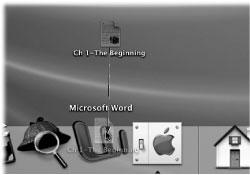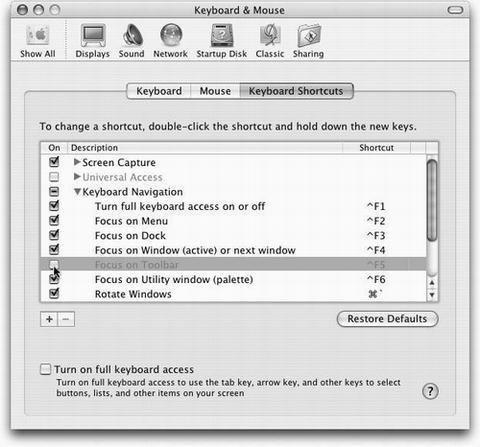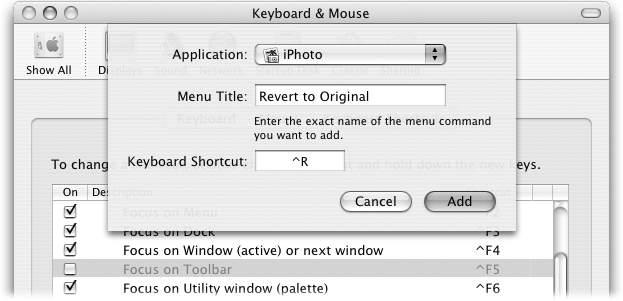Mac OS X offers a fantastic feature for anyone who believes that life is too short: keyboard-controllable menus, dialog boxes, pop-up menus, and even Dock pop-up menus. You can operate every menu in every program without the mouse or add-on software.
Panther, in fact, takes this concept to a new extreme. You can now operate every control
in every dialog box from the keyboard, including pop-up menus and checkboxes.
And you can even redefine many of the built-in Mac OS X keystrokes, like Shift-![]() -3
to capture the screen as a graphic.
-3
to capture the screen as a graphic.
In fact, Mac OS X 10.3 even lets you add or change any menu command in any program. If you’re a keyboard-shortcut lover, your cup runneth over.
Here are some of the ways you can control your Mac mouselessly. In the following descriptions, you’ll encounter the factory settings for the keystrokes that do the magic—but as you’ll note in a moment, you can change these key combos to anything you like. (That’s fortunate, since many of them, out of the box, conflict with canned brightness and volume keystrokes for PowerBooks and iBooks.)
When you press Control-F2, the ![]() - menu drops down. At this point, you can highlight
individual commands on that menu by pressing the up or down arrow keys, or even
typing the first couple letters of the command you want.
- menu drops down. At this point, you can highlight
individual commands on that menu by pressing the up or down arrow keys, or even
typing the first couple letters of the command you want.
You move to a different menu by pressing the right and left arrow keys (or Tab and Shift-Tab). And you can “click” a menu command by pressing Enter, Return, or the Space bar.
You can also close the menu without making a selection by pressing Esc or ![]() period.
period.
Once you’ve pressed Control-F3, you can move to highlight any icon on the Dock by pressing the appropriate arrow keys (or, once again, Tab and Shift-Tab).
Then, once you’ve highlighted a Dock icon, you “click it” by pressing Enter or the
Space bar. Again, if you change your mind, press Esc or ![]() -period.
-period.
Tip
Once you’ve highlighted a disk or folder icon, you can press the up or down arrow to make the list of its contents appear. (If you’ve positioned the Dock vertically, use the left or right arrow instead!)
Using the arrow keys, you can now highlight and open virtually anything in any disk or folder on the Dock. Similarly, once you’ve highlighted the icon of an application that has several windows open, you can press the up and down arrows to highlight the name of an individual window. When you press Enter, that window pops to the front.
Every time you press Control-F4, you bring the next window forward, eventually cycling through every window in every open program. Add the Shift key to cycle through them in the opposite order.
Of course, you may remember from Chapter 1 that Mac OS X offers a different
keystroke for cycling through the different windows in your current program (it’s
![]() -~, the tilde symbol at the upper-left of your keyboard). This keystroke, on the
other hand, tours all windows in all programs. Both keystrokes are useful in different
situations.
-~, the tilde symbol at the upper-left of your keyboard). This keystroke, on the
other hand, tours all windows in all programs. Both keystrokes are useful in different
situations.
This one is on the unpredictable side, but it more-or-less works in most programs that display a Mac OS X-style toolbar: the Finder, System Preferences, Sherlock, the iPhoto editing window, and so on.
When you press Control-F5, you highlight the first button on that toolbar. Move the “focus” by pressing the arrow keys or Tab and Shift-Tab. Then tap Enter or the Space bar to “click” the highlighted button.
In a few programs that feature floating tool palettes, you can highlight the frontmost palette by pressing Control-F6. At this point, use the arrow keys to highlight the various buttons on the palette. You can see the effect when, for example, you’re editing text in TextEdit and you’ve also opened the Font palette. Pressing Control-F6 highlights the Font palette, taking the “focus” off your document.
Figure 4-11. Turn off any checkboxes for keystrokes that you never use especially if they seem to conflict with identical keyboard shortcuts in your programs. In fact, there’s even a keystroke that turns off all of the “full keyboard access” keystrokes (the ones that let you control menus, Dock, toolbars, palettes, and so on) all at once: Control-F1. (Don’t mean to hurt your brain, but you can actually turn off even that keystroke.)
Mac OS X 10.3 also lets you navigate and manipulate any dialog box from the keyboard. When this feature is turned on, pressing the Tab key highlights the next control of any type, whatever it may be—radio button, pop-up menu, and so on. Press the Space bar to “click” a button or open a pop-up menu. Once a menu is open, use the arrow keys (or type letter keys) to highlight commands on it, and the Space bar to “click” your choice.
At the bottom of the Keyboard & Mouse panel of System Preferences, you’ll see a checkbox called, “Turn on full keyboard access.” When that checkbox is off, pressing the Tab key works only to move among text boxes in the dialog box. It skips over radio buttons, pop-up menus, and checkboxes.
Suppose you love iPhoto (and who doesn’t?). But one thing drives you crazy: The Revert to Original command, which discards all the changes you’ve ever made since taking the photo, has no keyboard equivalent. You must trek up to the menu bar every time you need that command.
Or maybe it drives you crazy that the Hide command is ![]() -H in most programs, but
not, for some nutty reason, in Photoshop.
-H in most programs, but
not, for some nutty reason, in Photoshop.
This is why Panther lets you add keyboard shortcuts to menu commands that lack them—or change the command in programs whose key assignments break with tradition. (It works in any program that uses the standard Mac OS X menu software, which rules out Microsoft Word.) Here’s the routine:
Choose
 →
System Preferences. Click the Keyboard & Mouse button. Click the
Keyboard Shortcuts tab button.
→
System Preferences. Click the Keyboard & Mouse button. Click the
Keyboard Shortcuts tab button.
You arrive at the dialog box shown in Figure 4-11.
Click the + button just beneath the list.
The dialog box shown in Figure 4-12appears.
Indicate which program needs behavior modification.
In this example, you’d choose iPhoto from the Application pop-up menu. (If the program’s name doesn’t appear in the pop-up menu, choose Other; navigate to, and double-click, the program you want.)
Figure 4-12. If you choose All Applications from the top pop-up menu, you can change the keyboard combo for a certain combo command wherever it appears. You could, for example, change the keystroke for Page Setup, in every program at once.
Carefully type in the name of the menu command whose keyboard shortcut you want to change or add.
Type it exactly as it appears in the menu, complete with capitalization and the little ellipsis (...) that may follow it. (You make the ellipsis character by pressing Option-semicolon.)
Click in the Keyboard Shortcut box. Press the new or revised key combo you want.
For example, press Control-R (for iPhoto’s Revert to Original command). You’ll see the Mac’s notation of your keystroke appear in the Keyboard Shortcut box—unless, of course, the combo you selected is already in use within that program. In that case, you hear only an error sound that means, “Try again.”
Click Add.
The dialog box closes. By scrolling down in your Keyboard Shortcuts list, you’ll see that the keystroke you selected has now been written down for posterity under the appropriate program’s flippy triangle. (To get rid of it, click its name and then click the - button beneath the list.)
The next time you open the program you edited, you’ll see that the new keystroke is in place.
Get Mac OS X: The Missing Manual, Panther Edition now with the O’Reilly learning platform.
O’Reilly members experience books, live events, courses curated by job role, and more from O’Reilly and nearly 200 top publishers.




